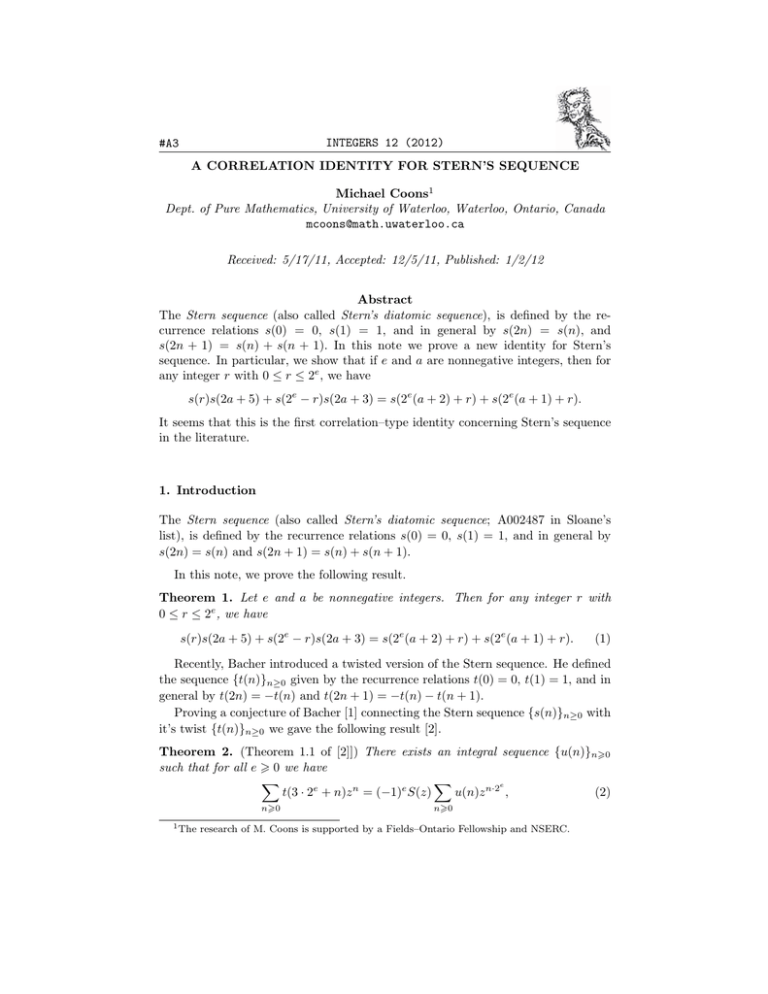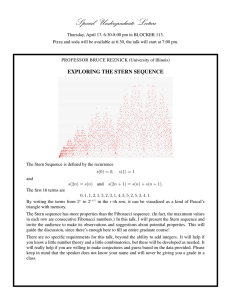INTEGERS 12 (2012) #A3 A CORRELATION IDENTITY FOR STERN’S SEQUENCE Michael Coons
advertisement

INTEGERS 12 (2012)
#A3
A CORRELATION IDENTITY FOR STERN’S SEQUENCE
Michael Coons1
Dept. of Pure Mathematics, University of Waterloo, Waterloo, Ontario, Canada
mcoons@math.uwaterloo.ca
Received: 5/17/11, Accepted: 12/5/11, Published: 1/2/12
Abstract
The Stern sequence (also called Stern’s diatomic sequence), is defined by the recurrence relations s(0) = 0, s(1) = 1, and in general by s(2n) = s(n), and
s(2n + 1) = s(n) + s(n + 1). In this note we prove a new identity for Stern’s
sequence. In particular, we show that if e and a are nonnegative integers, then for
any integer r with 0 ≤ r ≤ 2e , we have
s(r)s(2a + 5) + s(2e − r)s(2a + 3) = s(2e (a + 2) + r) + s(2e (a + 1) + r).
It seems that this is the first correlation–type identity concerning Stern’s sequence
in the literature.
1. Introduction
The Stern sequence (also called Stern’s diatomic sequence; A002487 in Sloane’s
list), is defined by the recurrence relations s(0) = 0, s(1) = 1, and in general by
s(2n) = s(n) and s(2n + 1) = s(n) + s(n + 1).
In this note, we prove the following result.
Theorem 1. Let e and a be nonnegative integers. Then for any integer r with
0 ≤ r ≤ 2e , we have
s(r)s(2a + 5) + s(2e − r)s(2a + 3) = s(2e (a + 2) + r) + s(2e (a + 1) + r).
(1)
Recently, Bacher introduced a twisted version of the Stern sequence. He defined
the sequence {t(n)}n≥0 given by the recurrence relations t(0) = 0, t(1) = 1, and in
general by t(2n) = −t(n) and t(2n + 1) = −t(n) − t(n + 1).
Proving a conjecture of Bacher [1] connecting the Stern sequence {s(n)}n≥0 with
it’s twist {t(n)}n≥0 we gave the following result [2].
Theorem 2. (Theorem 1.1 of [2]]) There exists an integral sequence {u(n)}n!0
such that for all e ! 0 we have
!
!
e
t(3 · 2e + n)z n = (−1)e S(z)
u(n)z n·2 ,
(2)
n!0
1 The
n!0
research of M. Coons is supported by a Fields–Ontario Fellowship and NSERC.
2
INTEGERS: 12 (2012)
where S(z) denotes the generating function of the Stern sequence.
Note that in this theorem (as in the original conjecture), it is implicit that the
sequence {u(n)}n!0 is defined by the relationship
"
n
!
n!0 t(3 + n)z
n
U (z) :=
u(n)z =
.
S(z)
n!0
We will prove Theorem 1 as a corollary of Theorem 2.
2. Preliminaries
Lemma 3. The generating series S(z) =
tion
#
S(z 2 ) =
"
s(n)z n satisfies the functional equa$
S(z).
2
n!0
z
1+z+z
We will need the following lemmas (see [1, Theorem 1.2]).
Lemma 4. For all e ≥ 0 and for all n such that 0 ≤ r ≤ 2e we have s(2e + r) =
s(2e − r) + s(r).
Lemma 5. (Bacher [1]]) We have t(3 · 2e + r) = t(6 · 2e − r) = (−1)e s(r) for all
e ! 0 and for all r such that 0 ≤ r ≤ 2e+1 .
Theorem 6. (Bacher [1]]) For all e ! 1, we have
e−1
%&
1+z
2i
+z
i=0
2i+1
'
e
3·2
(−1)e !
=
t(3 · 2e + n)z n .
z(1 + z 2e ) n=0
Using the definitions above, Theorem 6 and the functional equation for S(z), we
have that the right–hand side of (2) is
e
e
S(z) !
t(3 + n)z 2 n
S(z 2e )
n!0
(
)
e−1
% 1 + z 2i + z 2i+1
!
e
e
= (−1)
·
t(3 + n)z 2 n
i
2
z
i=0
n!0
(−1)e S(z)U (z 2 ) = (−1)e
e−1
' !
i
i+1
e
z %&
1 + z2 + z2
·
t(3 + n)z 2 n
e
2
z i=0
n!0
( e
)
3·2
!
!
e
1
2
n
e
n
= 2e
t(3 + n)z
t(3 · 2 + n)z
.
z (1 + z 2e )
n=0
= (−1)e
n!0
This calculation combined with Theorem 2 gives the following corollary.
3
INTEGERS: 12 (2012)
Corollary 7. For all e ! 0, we have
( e
)
3·2
!
!
e
e !
e
z 2 (1 + z 2 )
t(3 · 2e + n)z n =
t(3 + n)z 2 n
t(3 · 2e + n)z n . (3)
n!0
n=0
n!0
"
Now write the left–hand side of (3) as G(z) =
"
hand side of (3) as H(z) = n≥0 h(n)z n ; that is,
G(z) =
!
e
e
g(n)z n = z 2 (1 + z 2 )
n≥0
and
n≥0
!
n!0
!
(
2e n
g(n)z n and write the right–
t(3 · 2e + n)z n ,
e
3·2
!
)
Then we have
H(z) =
and
if n ∈ [0, 2e )
0
e+1
g(n) = t(2
+ n)
if n ∈ [2e , 2e+1 )
e+1
t(2
+ n) + t(2e + n) if n ∈ [2e+1 , ∞)
t(3 + n)z
n!0
h(n) =
!
2e k+j=n
0"j"3·2e
k∈N
n=0
t(3 · 2 + n)z
e
t(3 + k)t(3 · 2e + j).
n
.
(4)
(5)
Note that if we let k = 0, then t(3 + k) = 0, so that we can assume that k ∈ N.
Also, it is easy to see that we can rewrite (5) as
!
h(n) =
t(3 + k)t(3 · 2e + n − 2e k).
(6)
n
2e
−3"k" 2ne
2 3
Note that n − 2e 2ne = r mod 2e , where r is the residue of n modulo 2e which
lies in the set {0, 1, . . . , 2e − 1}. Thus,
4n5
n − 2e e = r,
&4 n 5 2 '
e
n−2
− 1 = r + 2e ,
e
2
&4 n 5
'
n − 2e
−
2
= r + 2 · 2e ,
2e
6
7
where r is defined as above. Thus all the values of 3 · 2e + n − 2e k for k ∈ 2ne − 3, n3
lie in the interval (3 · 2e + 1, 6 · 2e − 1), and thus (6) becomes
&
4 n 5'
&
4 n 5'
&
4 n 5'
h(n) = t 3 + e t(3·2e +r)+t 2 + e t(4·2e +r)+t 1 + e t(5·2e +r).
2
2
2
4
INTEGERS: 12 (2012)
Applying Lemma 5 we have that
t(5 · 2e + r) = t(6 · 2e − (2e − r)) = t(3 · 2e + (2e − r)) = t(4 · 2e − r),
and thus the above equality becomes
&
4 n 5'
&
4 n 5'
&
4 n 5'
h(n) = t 3 + e t(3·2e +r)+t 2 + e t(4·2e +r)+t 1 + e t(4·2e −r),
2
2
2
or rather
&
4 n 5'
&
4 n 5'
h(n) = t 3 + e t(3 · 2e + r) + t 2 + e t(3 · 2e + r + 2e )
2
2
&
4 n 5'
+ t 1 + e t(3 · 2e − r + 2e ).
2
(7)
With this identity for h(n) in hand, we are ready to prove Theorem 1.
3. Proof of Theorem 1
Proof of Theorem 1. Let e and a be nonnegative integers, and let r be an integer
with 0 ≤ r ≤ 2e . To prove Theorem 1 we will show that the right–hand side of
(1) is equal to the left–hand side of (1). To this end, define b := 2e a + r. Then the
right–hand side of (1) becomes
s(2e (a + 2) + r) + s(2e (a + 1) + r) = s(2e a + r + 2 · 2e ) + s(2e a + r + 2e )
= s(b + 2 · 2e ) + s(b + 2e ).
Let k be any positive integer satisfying k ≥ log2 (a + 3) + e, and note that this
implies that b ≤ 2k so that both b + 2 · 2e and b + 2e are less than or equal to 2k+1 .
Then applying Lemma 5 we have
8
9
s(2e (a + 2) + r) + s(2e (a + 1) + r) = (−1)k t(3 · 2k + b + 2 · 2e ) + t(3 · 2k + b + 2e ) .
Since k ≥ e and b ≥ 0 we have 3 · 2k + b ! 2e+1 , so that the previous equality yields
(−1)k g(3 · 2k + b) = s(2e (a + 2) + r) + s(2e (a + 1) + r),
(8)
where g(n) is as in (4).
By Theorem 2 we have that g(n) = h(n) for all n ≥ 0, so that using identity (7)
and the definition of b yields
INTEGERS: 12 (2012)
5
!
"
#$
!
"
#$
3 · 2k + b
3 · 2k + b
e
g(3 · 2k + b) = t 3 +
t(3
·
2
+
r)
+
t
2
+
t(3 · 2e + r + 2e )
2e
2e
!
"
#$
3 · 2k + b
+t 1+
t(3 · 2e − r + 2e )
2e
!
"
#$
3 · 2k + 2e a + r
=t 3+
t(3 · 2e + r)
2e
!
"
#$
3 · 2k + 2e a + r
+t 2+
t(3 · 2e + r + 2e )
2e
!
"
#$
3 · 2k + 2e a + r
+t 1+
t(3 · 2e − r + 2e )
2e
= t(3 · 2k−e + a + 3)t(3 · 2e + r) + t(3 · 2k−e + a + 2)t(3 · 2e + r + 2e )
+ t(3 · 2k−e + a + 1)t(3 · 2e − r + 2e ).
Since k ≥ log2 (a + 3) + e we have that a + j ≤ 2k−e for j = 1, 2, 3, and so we may
apply Lemma 5. Thus continuing the proceeding equalities by applying Lemma 5
several times, we have
:
;
g(3 · 2k + b) = (−1)k s(a + 3)s(r) + s(a + 2)s(2e + r) + s(a + 1)s(2e − r) .
We now use Lemma 4 and gather the terms with s(r) and s(2e − r) to get
:
;
g(3 · 2k + b) = (−1)k s(r)(s(a + 3) + s(a + 2)) + s(2e − r)(s(a + 2) + s(a + 1) ,
so that using the definition of the Stern sequence we have
:
;
g(3 · 2k + b) = (−1)k s(r)s(2a + 5) + s(2e − r)s(2a + 3) .
To complete the proof we apply identity (8) to the left–hand side to give
s(2e (a+2)+r)+s(2e (a+1)+r) = (−1)k g(3·2k +b) = s(r)s(2a+5)+s(2e −r)s(2a+3),
which is the desired result.
References
[1] R. Bacher, Twisting the Stern sequence, preprint, http://arxiv.org/pdf/ 1005.5627.
[2] M. Coons, On some conjectures concerning Stern’s sequence and its twist, Integers 11 (2011),
A35, 14pp.
[3] K. Dilcher and K. Stolarsky, A polynomial analogue of the Stern sequence, Int. J. Number
Theory 3 (2007), no. 1, 85–103.
[4] M. A. Stern, Über eine zahlentheoretische Function, J. Reine Angew. Math. 55 (1858), 193–
220.




